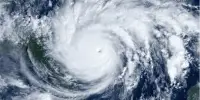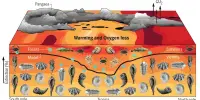Climate change is hastening sound transmission in the oceans, and the way it varies across the globe is influenced by physical properties of the oceans. Two ‘acoustic hotspots’ of future sound speed increases are predicted east of Greenland and in the Northwest Atlantic Ocean east of Newfoundland. If current high rates of greenhouse gas emissions continue through 2100, the average speed of sound in these locations is likely to increase by more than 1.5 percent.
According to a new global study that identified future ocean “acoustic hotspots,” climate change will significantly alter how sound travels underwater, potentially affecting natural soundscapes as well as emphasizing human-generated noise. These changes in ocean soundscapes may have an impact on marine life’s essential activities.
In warmer water, sound waves propagate faster and last longer before dying away.
“We calculated the effects of temperature, depth, and salinity based on public data to model the future soundscape,” said Alice Affatati, a bioacoustics researcher at Memorial University of Newfoundland and Labrador in St. John’s, Canada, and lead author of the new study, which was published in Earth’s Future, AGU’s journal for interdisciplinary research on our planet and its inhabitants. It is the first global estimate of ocean sound speed that has been linked to future climate.
According to the new study, two hotspots in the Greenland Sea and a patch of the northwestern Atlantic Ocean east of Newfoundland can expect the most change at 50 and 500 meter depths. Given continued high greenhouse gas emissions, the average speed of sound in these waters from the surface to depths of 500 meters (1,640 feet) is likely to increase by more than 1.5 percent, or approximately 25 meters per second (55 miles per hour), by the end of the century (RCP8.5).
We calculated the effects of temperature, depth, and salinity based on public data to model the future soundscape. It is the first global estimate of ocean sound speed that has been linked to future climate.
Alice Affatati
“The major impact is expected in the Arctic, where we know already there is amplification of the effects of climate change now. Not all the Arctic, but one specific part where all factors play together to give a signal that, according to the model predictions, overcomes the uncertainty of the model itself,” said author Stefano Salon, a researcher at the National Institute of Oceanography and Applied Geophysics in Trieste, Italy.
The ocean soundscape is a cacophony of vibrations generated by living organisms, natural phenomena such as waves and cracking ice, as well as ship traffic and resource extraction. At 50 meters depth, sound speed ranges from 1,450 meters per second in polar regions to 1,520 meters per second in equatorial waters (3,243 to 3,400 miles per hour, respectively).
Many marine animals communicate with one another and navigate their underwater world using sound. According to the authors, changing the sound speed can affect their ability to feed, fight, find mates, avoid predators, and migrate.

Changing soundscapes
In addition to the notable hotpots around Greenland and in the northwestern Atlantic Ocean, the new study found a 1% sound speed increase, more than 15 meters per second, at 50 m in the Barents Sea, northwestern Pacific, and in the Southern Ocean (between 0 and 70E), and at 500 m in the Arctic Ocean, Gulf of Mexico, and southern Caribbean Sea.
Temperature, pressure as depth increases, and salinity all influence how fast and far sound travels in water. The researchers focused on hotspots where the climate signal stood out clearly from model uncertainty and was greater than seasonal variability in the new study.
The new study also modeled common vocalizations of the North Atlantic right whale, a critically endangered species that lives in both north Atlantic acoustic hotspots, under projected future conditions. The whales’ typical “upcall” at 50 Hertz is likely to travel further in a warmer future ocean, according to the researchers.
“We chose to focus on one megafauna species, but many trophic levels in the ocean are affected by or use sound,” Affatati explained. “All of these hotspots are rich in biodiversity.” The global soundscape will be combined with other maps of anthropogenic impacts in the oceans in the future to pinpoint areas of combined stressors or direct needed observational research.
“Combining different approaches is the way to go with complicated problems like climate change,” said author Chiara Scaini, an environmental engineer at the National Institute of Oceanography and Applied Geophysics.
















